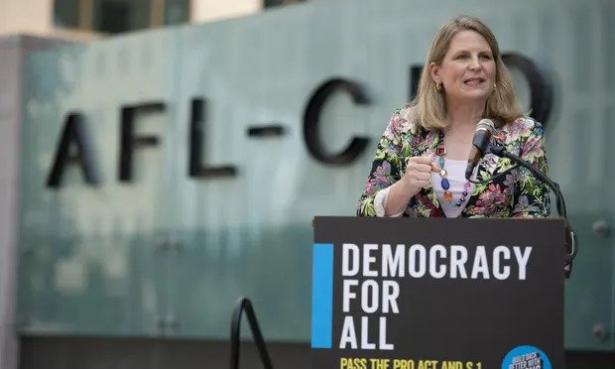In light of the youth-driven surge of union drives at Starbucks, Amazon, Apple and elsewhere, the AFL-CIO – the main US’s labor federation – is facing growing pressure to undertake a bolder effort to help today’s burst of unionizing expand far faster.
At the AFL-CIO’s convention in Philadelphia, Liz Shuler, the federation’s president, unveiled a new effort, announcing: “In the next 10 years we will organize and grow our movement by more than 1 million working people. How’s that for a goal!”
Shuler received a standing ovation, but several union presidents later said they were underwhelmed by the goal, which would mean growth of 100,000 union members annually or less than 1% a year for the nation’s unions.
“I applaud putting out a goal,” said D Taylor, president of Unite Here, the hotel workers’ union. “But I think that number is too low. We have to aim much higher.” In the year before the pandemic, Taylor said, his union organized 22,000 workers, increasing its membership by 8% that year.
Mark Dimondstein, president of the American Postal Workers Union, said: “I like the new emphasis on organizing. I like the slogan ‘organize and rise’. But I think we should be far bolder. Remember, the CIO [the Congress of Industrial Organizations] organized 2 or 3 million workers in six months or a year in some of its great periods [in the 1930s]. We shouldn’t be doing this in an incremental way, especially when people are so inspired. We should do this in a bold way.”
The convention’s slogan was “Building the movement to meet the moment”. The AFL-CIO has often been faulted for doing too little to spur organizing; the percentage of US workers in unions has slid from 35% in the 1950s to 20% in the 1980s to 10% today.
In a briefing with journalists, Shuler defended her 1 million goal, saying it was “a goal that everybody rallies around”. She added: “It’s a target, it’s a threshold, that we could get every union in the federation to buy into, which is a feat in and of itself.” Shuler – who was elected on Sunday to a four-year term as AFL-CIO president after succeeding Richard Trumka after he died last August – said this was the first time the federation was setting “measurable” organizing goals that each union was expected to meet.
Speaking at the convention, the labor secretary, Marty Walsh, a former building trades union leader, praised Shuler’s 1 million goal, but he also called for more action. Noting today’s huge excitement about unionizing, Walsh said: “It’s your time right now, for the labor movement to get off our ass and do our job … You can’t sit on your ass and think it’s going to come to you. You need to go out and get it.”
Randi Weingarten, president of the American Federation of Teachers, lauded Shuler’s plan, saying it was smart to put forward a firm numerical goal “as opposed to simply an aspiration”. “Sometimes it’s important to put a number out there that makes it real,” Weingarten said. “Is it too low? Of course it’s too low. Do we want to organize millions and millions? Of course. Are we going to change 60 years of anti-union behavior in this country in three and a half nanoseconds? No.”
Shuler said the federation was helping some of today’s most exciting organizing drives, including the effort to unionize the Amazon warehouse in Bessemer, Alabama, where the Retail, Wholesale and Department Store Union is trailing after the preliminary vote count, but could still prevail when challenged ballots are tallied. Shuler said outside unions provided 100 organizers to help the Bessemer effort.
Dimondstein criticized the convention’s roster of speakers for not including worker-organizers from the Starbucks organizing drive or the Amazon Labor Union, which unionized an 8,300-employee Amazon warehouse in New York in a landmark victory. Neither the Starbucks union, Workers United, nor the Amazon Labor Union is in the AFL-CIO.
Sara Nelson, president of the Association of Flight Attendants, said that historically the labor movement has grown only when young workers took the lead. “We’re not in a place where the AFL-CIO is going to take the lead on the strategy for the next generation,” she said. “That means we’re not doing enough.”
Lee Saunders, president of the American Federation of State, County and Municipal Employees, said he wasn’t so concerned about numerical goals as about “developing and strategizing an organizing program that is treated as a priority”. While there have been ad hoc efforts to help various drives, like the Amazon Labor Union’s, Saunders said, “when you go up against these multibillion organizations, you’re going to need a structure [perhaps a multi-union, cooperative effort] that’s going to help you handle it”.
Saunders added that if workers “win a campaign, corporations can file lawsuits and delay on negotiating a contract. You need a structure that can help battle that.”
Some labor leaders complained that Schuler’s 1 million plan was lowest common denominator unionism. But Shuler sees that plan as lifting the floor: unions that do lots of organizing can continue to do so, while this plan should get unions that do little organizing to commit to doing more.
Shuler announced the creation of the Center for Transformational Organizing, a group of strategists, organizers and researcher who will focus on how to unionize new-economy companies. “We have a visionary way forward,” Shuler said.
===


Spread the word